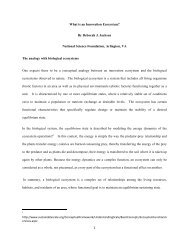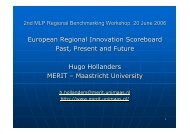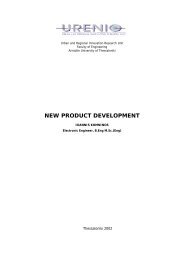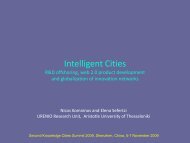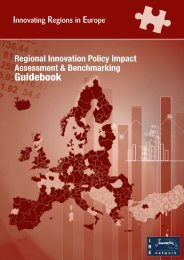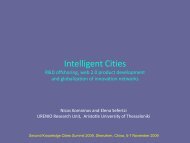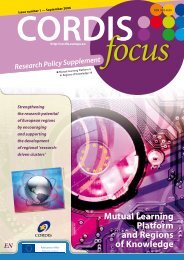Creating smart systems, guide to Cluster strategies in less favoured
Creating smart systems, guide to Cluster strategies in less favoured
Creating smart systems, guide to Cluster strategies in less favoured
You also want an ePaper? Increase the reach of your titles
YUMPU automatically turns print PDFs into web optimized ePapers that Google loves.
8 | A GUIDE TO CLUSTER STRATEGIES IN LESS FAVOURED REGIONS<br />
supplier, or develop a new concept—the route taken, for example, <strong>in</strong> the development of<br />
Ireland’s <strong>in</strong>formation and communications technology cluster.<br />
B. Connections<br />
The most successful clusters build mechanisms that can speed the movement of ideas,<br />
<strong>in</strong>novations, and <strong>in</strong>formation from firm <strong>to</strong> firm throughout the economy. The dynamics of<br />
clusters, not the <strong>in</strong>dividual accomplishments, create the learn<strong>in</strong>g region and <strong>in</strong>novation<br />
cluster. The mechanisms and entities for collect<strong>in</strong>g and dissem<strong>in</strong>at<strong>in</strong>g knowledge—the<br />
gatekeepers, brokers, and <strong>in</strong>termediaries that encourage and facilitate all forms of<br />
associative behaviour—provide the value embodied <strong>in</strong> social capital that is so important <strong>to</strong><br />
cluster competitiveness.<br />
Network<strong>in</strong>g and Networks. The s<strong>in</strong>gle most important operat<strong>in</strong>g pr<strong>in</strong>ciple of competitive<br />
clusters is the ability <strong>to</strong> network extensively and form networks selectively. Network<strong>in</strong>g is<br />
the process that moves and spreads ideas, <strong>in</strong>formation, and best practices throughout a<br />
cluster and imports them from other places. A “network,” as used here, is the collaborative<br />
structure among small and mid-sized enterprises (SMEs). By the late 1980s, networks<br />
had become a popular policy <strong>to</strong>ol throughout the <strong>in</strong>dustrialised world. These networks<br />
were formally structured coalitions of firms that ranged from jo<strong>in</strong>t ventures created by legal<br />
contracts <strong>to</strong> bus<strong>in</strong>ess associations formed by noth<strong>in</strong>g more b<strong>in</strong>d<strong>in</strong>g than annual<br />
membership dues. The former depended heavily on co-operation and trust, the latter on<br />
the value of services and network<strong>in</strong>g opportunities. A region that is home <strong>to</strong> a critical<br />
mass of <strong>in</strong>terdependent companies and that has a social <strong>in</strong>frastructure as well as a set of<br />
<strong>in</strong>termediaries facilitat<strong>in</strong>g associative behaviour and specialised support services produces<br />
networks with or without government-sponsored network programmes.<br />
Connections and <strong>in</strong>termediaries. The limits or constra<strong>in</strong>ts <strong>to</strong> active participation <strong>in</strong> a<br />
successful cluster are largely a function of lack of “connections,” or deficits <strong>in</strong> social<br />
capital. Some of a region’s s<strong>to</strong>ck of social capital resides <strong>in</strong> its civic and professional<br />
associations, and its economic value is deeply embedded <strong>in</strong> the functions of groups that<br />
br<strong>in</strong>g people <strong>to</strong>gether <strong>to</strong> share ideas and knowledge. A variety of entities that work with<br />
clusters, <strong>in</strong>clud<strong>in</strong>g technology centres, NGOs, or skills councils, serve as gateways <strong>to</strong><br />
<strong>in</strong>formation, knowledge, and labour and as l<strong>in</strong>k<strong>in</strong>g agents.<br />
C. Competencies<br />
Although many fac<strong>to</strong>rs affect the competitive advantages of clusters, none is as important<br />
as its competencies they embody. Learn<strong>in</strong>g and knowledge transfer represent the<br />
lifeblood and skilled labour the gene pool, of clusters. 2<br />
Specialised work force. The skills and knowledge of the work force have soared <strong>to</strong> the<br />
<strong>to</strong>p of the list of bus<strong>in</strong>esses’ requirements. As bus<strong>in</strong>esses become more technology<br />
dependent, they need more highly skilled, educated, and talented employees. While other<br />
cluster <strong>in</strong>puts such as parts, suppliers, and services can <strong>to</strong>day be more easily sourced<br />
from afar us<strong>in</strong>g the Internet and overnight deliveries, the work force rema<strong>in</strong>s a local<br />
resource constra<strong>in</strong>ed by acceptable commut<strong>in</strong>g patterns. Chang<strong>in</strong>g demographics and<br />
preferences only re<strong>in</strong>force the critical nature of a skilled labour supply. Decl<strong>in</strong><strong>in</strong>g birth<br />
2<br />
Jane Jacobs, The Nature of Economies, New York: Modern Library, 2000.




